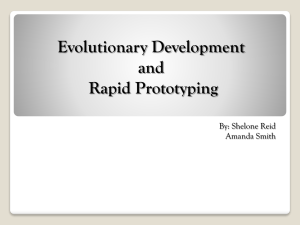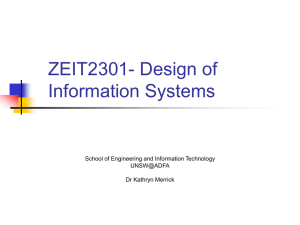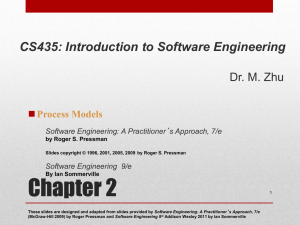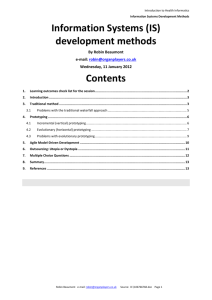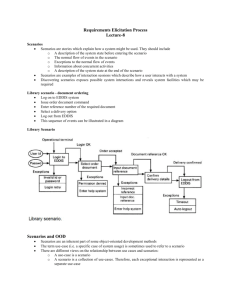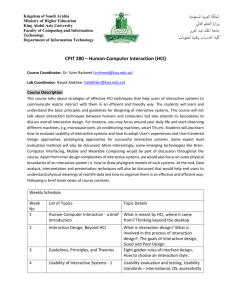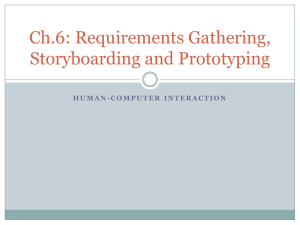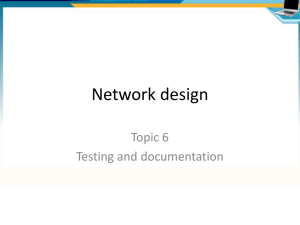Introduction to Health Informatics
advertisement
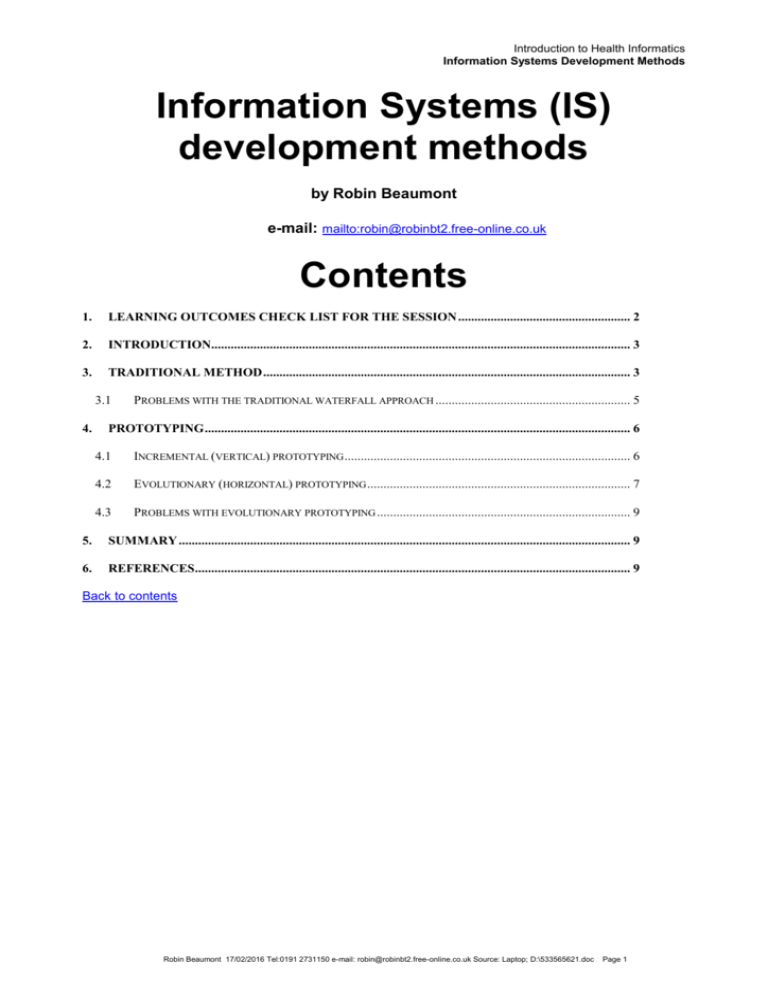
Introduction to Health Informatics
Information Systems Development Methods
Information Systems (IS)
development methods
by Robin Beaumont
e-mail: mailto:robin@robinbt2.free-online.co.uk
Contents
1.
LEARNING OUTCOMES CHECK LIST FOR THE SESSION ..................................................... 2
2.
INTRODUCTION................................................................................................................................. 3
3.
TRADITIONAL METHOD ................................................................................................................. 3
3.1
4.
PROBLEMS WITH THE TRADITIONAL WATERFALL APPROACH ............................................................ 5
PROTOTYPING ................................................................................................................................... 6
4.1
INCREMENTAL (VERTICAL) PROTOTYPING ........................................................................................ 6
4.2
EVOLUTIONARY (HORIZONTAL) PROTOTYPING ................................................................................. 7
4.3
PROBLEMS WITH EVOLUTIONARY PROTOTYPING .............................................................................. 9
5.
SUMMARY ........................................................................................................................................... 9
6.
REFERENCES ...................................................................................................................................... 9
Back to contents
Robin Beaumont 17/02/2016 Tel:0191 2731150 e-mail: robin@robinbt2.free-online.co.uk Source: Laptop; D:\533565621.doc
Page 1
Introduction to Health Informatics
Information Systems Development Methods
1. Learning outcomes check list for the session
This section aims to provide you with a number of skills (the 'be able to's' below) and relevant information
(the 'know what's' below). Details are listed below. After you have completed the session you should
come back to these points ticking off those you feel happy with.
Learning outcome
Tick
box
Know what the traditional waterfall development
method is
Know the advantages and disadvantages of the
traditional waterfall approach
Know the two main types of prototyping
Be aware of the similarly between prototyping and the
audit cycle
Know the advantages and disadvantages of the
prototyping approach
Back to contents
Robin Beaumont 17/02/2016 Tel:0191 2731150 e-mail: robin@robinbt2.free-online.co.uk Source: Laptop; D:\533565621.doc
Page 2
Introduction to Health Informatics
Information Systems Development Methods
2. Introduction
This chapter describes the various and conflicting approaches taken to developing (possibly
computerised) information systems (IS). Back to contents
3. Traditional method
The traditional method of developing computer Information Systems (ISs) is often referred to as the
waterfall approach. The key stages are shown below. An analyst (=modeller) would come along and
possibly convert a narrative document written by yourself into a system design document (called amongst
other things a system specification or software requirements specification SRS). Basically this would
involve describing how a system (software and hardware) would need to be set-up to fulfil your
requirements. You may have specified your requirements in the form of a list of functions you would want
the IS to perform called a Functional Specification. The functional specification may adopt a three tier
level of compliance:
The function must be met
The function should be met. Indicates that the function must be met unless a waiver can be agreed
upon
The function is optional. Indicates that this would be preferred but is not mandatory.
She / he would make copious use of various diagrams such as flow diagrams (the precursor to dynamic
modelling described in the next section), entity diagrams (the precursor to object models) and a data
dictionary. By way of a technique known as Structured analysis and design. These documents would
then be refined further and eventually translated into a particular programming language (COBOL, BASIC,
FORTRAN etc.) to instruct the computer how to behave to imitate the specification. Once the system was
up and running a Post Implementation Review (PIR) would be carried out. It is important to note that
once the analysis process was completed there would be no further contact between the system
developers and the purchaser until they received the system.
Traditional Waterfall Approach to Systems Development
Statement of Requirements
Requirements analysis
System design
Detailed system design
Implementation
Post Implementation
Review
Robin Beaumont 17/02/2016 Tel:0191 2731150 e-mail: robin@robinbt2.free-online.co.uk Source: Laptop; D:\533565621.doc
Page 3
Introduction to Health Informatics
Information Systems Development Methods
The above approach has a clear number of stages each with a deliverable. The progression from one
stage to another is in one direction, always forward and never backwards. Finally there is a clear
completion stage in the process. This system worked fine when:
The task was relatively simple (e.g. computerising an invoicing system)
The analyst could understand the situation easily (i.e. did not require domain specific
knowledge)
Expectations where low
The system did not need to continually adapt
The above description of how software may be developed is often called a software development life
cycle. The method described above is often referred to as the waterfall lifecycle because of its unidirectional nature. The whole development process of analysis and design including or excluding software
development, depending upon your viewpoint, is often referred to as systems modelling. This will be
discussed in much greater detail in subsequent sections.
Just in case your thinking that there are only a few methods of developing systems you should note that
James Martin 1990 (book 3; p. 450) describes in detail eight categories of software lifecycle, including all
the analysis stages where appropriate.
Back to contents
Exercise 1.
From a clinicians or end users perspective list some of the advantages and disadvantages of
the above waterfall lifecycle.
Exercise 2.
From a managers perspective list some of the advantages and disadvantages of the above
waterfall lifecycle.
Back to contents
Robin Beaumont 17/02/2016 Tel:0191 2731150 e-mail: robin@robinbt2.free-online.co.uk Source: Laptop; D:\533565621.doc
Page 4
Introduction to Health Informatics
Information Systems Development Methods
3.1 Problems with the traditional waterfall approach
Problems with the above traditional method became increasingly acute as more complex software was
developed for areas which had not traditionally been suitable for computer systems. Originally computer
systems mimicked clerical operations such as invoicing and bookkeeping, with clearly defined procedural
tasks and relatively simple data. Very different from the process of a patient moving through a hospital
stay or a doctor caring for a long term patient with renal failure.
Specific problems associated with the traditional approach included:
Rigidity
Lack of input from various user perspectives
Difficulty in revisiting previous stages as a result of subsequent lessons learnt
Knowledge and control firmly in the hands of the Analysts ('experts').
The traditional waterfall approach incorporated a specific method of specifying the IS known as structured
analysis and design which presented its own problems:
Structured Analysis and Design created an unnatural division between the data and process aspects of
the IS. Consequently the proposed system was inadequately specified.
The unreal division of describing data and process aspects was difficult for people to understand.
The central issue was the belief that it was possible to elucidate the true requirements from the
stakeholders. However both the stakeholders and the analysts were equally unsuitable to specify the
requirements. The stakeholders where usually the commissioners of the project who understood little of
the realities of what would make a successful implementation. Similarly the analysts lacked domain
expertise (i.e. in the Healthcare arena possessed no health care knowledge). Along with these conceptual
problems there existed (and still exists) a over optimistic belief that requirements could be specified using
the various analysis techniques around. A famous software book The mythical Man-Month, by Brooks
(1975) breaks the seal on the mythical waterfall approach to systems design:
"In most projects the first system built is barely usable. It may be too slow, too big,
awkward to use, or all the three. There is no alternative but to start again, smarting but
smarter, and built a redesigned version in which these problems are solved….
The management question is, therefore, is not whether to build a pilot system and
throw it away. You will do that. The only question is whether to plan in advance to
build a throwaway, or to promise to deliver the throwaway to the customer. Seen this
way, the answer is much clearer."
Quoted in Beyond Programming Bruce Blum OUP 1996 p.253
Many different solutions to these problems have been offered. However we will concentrate on two,
Prototyping and participative design methods. Prototyping will be considered in this section and
participative design methods elsewhere in this chapter.
Back to contents
Exercise 3.
Suggest some solutions to the problems associated with the traditional waterfall approach.
Robin Beaumont 17/02/2016 Tel:0191 2731150 e-mail: robin@robinbt2.free-online.co.uk Source: Laptop; D:\533565621.doc
Page 5
Introduction to Health Informatics
Information Systems Development Methods
4. Prototyping
Although there are several varieties of prototyping we will only consider two:
Incremental
Evolutionary
Back to contents
4.1 Incremental (vertical) prototyping
Incremental prototyping is a method of developing a computer system by a process of delivering a small
but complete part of the system each time. Imagine building a kitchen by getting a new unit each month.
Each prototype therefore provides more facilities than the previous version. By way of an example
consider a maternity system. The system developers may decide upon the following delivery:
May '94 Patient Registration/ discharge facilities
Sept. '94 Basic reporting facilities
March '95 Clinical module
July '95 Clinical / audit report facilities
Nov. '95 Full reporting facilities and Casemix
Incremental prototyping therefore works by delivering a completely finished small part of the system each
time until a complete system eventually emerges.
Vertical (incremental) Prototyping - Nielsen 1993
Breath of system (different modules)
Functionality - how much
each module can do
Nielsen 1993 (p94)
describes this type of
prototyping
as
vertical prototyping.
You can see why by
looking
at
the
diagram below. The
depth
(height)
represents
the
functionality of the IS
and
the
width
represents the breath
of
the
system.
Therefore
an
incremental prototype
delivery represents a
vertical slice.
Vertical (incremental) prototype
This
is
contrast to the process of evolutionary prototyping described below.
Back to contents
Robin Beaumont 17/02/2016 Tel:0191 2731150 e-mail: robin@robinbt2.free-online.co.uk Source: Laptop; D:\533565621.doc
Page 6
in
direct
Introduction to Health Informatics
Information Systems Development Methods
4.2 Evolutionary (horizontal) prototyping
In this process the system designers create right from the start a mini system of the bare essential
facilities required. Taking the same example as above:
May '94 Basic Patient Registration/ discharge, clinical and reporting facilities
Sept. '94 Evaluation and review of requirements
March '95 Second attempt
July '95 Evaluation and review of requirements
Nov. '95 Formal development of final system
Evolutionary prototyping is therefore the process of developing a computer system by a process of
gradual refinement. Each refinement of the system contains a system specification and software
development phase. In contrast to both the traditional waterfall approach and incremental prototyping,
which required everyone to get everything right the first time this approach allows participants to reflect on
lessons learned from the previous cycle(s). It is usual to go through three such cycles of gradual
refinement. However there is nothing stopping a process of continual evolution which is often the case in
many systems.
Horizontal (evolutionary) Prototyping - Nielsen 1993
Breath of system (different modules)
Functionality - how much
each module can do
Nielsen 1993 (p94) describes this
type of prototyping as Horizontal
prototyping. You can see why by
looking at the diagram below
where
he
depth
(height)
represents the functionality of the
IS and the width represents the
breath of the system. Therefore an
incremental prototype represents a
horizontal slice
Horizontal (evolutionary) prototype
Evolutionary prototyping
1. Plan (+risk
assessment)
2. Develop
prototype
The diagram below shows the
evolutionary software development
lifecycle. Those of you who are familiar
with the audit cycle will note immediate
similarities, as will those of you who
know the nursing process.
Back to contents
Repeat cycle as
many times as you
want
3. Evaluate
prototype
Robin Beaumont 17/02/2016 Tel:0191 2731150 e-mail: robin@robinbt2.free-online.co.uk Source: Laptop; D:\533565621.doc
Page 7
Introduction to Health Informatics
Information Systems Development Methods
The diagram below shows the above lifecycle with three goes at development. This is based upon a
project I was involved in called Prodigy, which was developing the prescribing aspect of GP computer
systems.
Initial User
Requirement
User
Requirement
User
Requirement
Prototype
Evaluation
Prototype
(July-Dec ‘96)
Evaluation
Jan-June ‘97
Prototype
Acceptance
Testing
PRODUCT
Although this approach may seen radical it must be noted that the original article was published as long
ago as 1988 by Boehm who described in depth such a process alongside examples of its use. Possibly
this demonstrates just how far behind software development is in the health sector!
Exercise 4.
What additional resources may be required for the evolutionary prototyping approach over that
for the traditional waterfall approach.
Back to contents
Robin Beaumont 17/02/2016 Tel:0191 2731150 e-mail: robin@robinbt2.free-online.co.uk Source: Laptop; D:\533565621.doc
Page 8
Introduction to Health Informatics
Information Systems Development Methods
4.3 Problems with evolutionary prototyping
The main problems with evolutionary prototyping are due to poor management:
Lack of defined milestones
Lack of achievement - always putting off what would be in the present prototype until the next one
Lack of proper evaluation
Lack of clarity between a prototype and an implemented system
Lack of continued commitment from users. This process requires a greater degree of sustained
commitment from users for a longer time span than traditionally required. Users must be constantly
informed as to what is going on and be completely aware of the expectations of the 'prototypes'. This
is discussed in fair greater depth elsewhere in the chapter.
Exercise 5.
How might some of the above problems associated with evolutionary prototyping be solved.
A more detailed iterative prototyping development method which takes into account the above factors can
be found in chapter 12 section 'Getting the users involved'.
Back to contents
5. Summary
This chapter introduced the various ways Information Systems (ISs) can be developed in contrast to the
haphazard way most systems seem to have evolved. The traditional waterfall approach was described
and evaluated alongside the more modern alternative of prototyping. An example of how evolutionary
prototyping is being used in the health care arena was given. Iterative prototyping will be described in
greater depth latter in the chapter.
Back to contents
6. References
The article about evolutionary prototyping:
Boehm Barry 1988 A spiral model of software development and enhancement. Computer 21, 5 61 - 72.
A book describing the various approaches taken to software design over the years :
Blum Bruce 1996 Beyond programming. OUP. Oxford.
Nielsen J 1993 Usability Engineering. Academic press London
Back to contents
Document info:
Robin Beaumont Tel:(UK) 0191 2731150 e-mail: mailto:robin@robinbt2.free-online.co.uk Source: Laptop;
C:\HIcourseweb new\chap12\s3\des1.doc 15/09/1999 11:26
Robin Beaumont 17/02/2016 Tel:0191 2731150 e-mail: robin@robinbt2.free-online.co.uk Source: Laptop; D:\533565621.doc
Page 9
